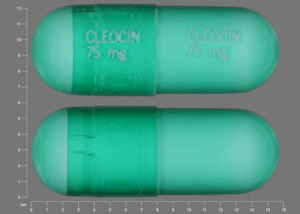Cleocin Dosage
Generic name: CLINDAMYCIN HYDROCHLORIDE 75mg
Dosage form: capsule
Drug class: Lincomycin derivatives
Medically reviewed by Drugs.com. Last updated on Jul 24, 2025.
If significant diarrhea occurs during therapy, this antibacterial drug should be discontinued (See BOXED WARNING).
Administer CLEOCIN HCl Capsules with a full glass of water (6 to 8 ounces, approximately 200 to 250 mL) and at least 30 minutes before lying down to reduce the potential for esophageal irritation (See ADVERSE REACTIONS).
Adults: Serious infections – 150 to 300 mg every 6 hours. More severe infections – 300 to 450 mg every 6 hours.
Pediatric Patients (who are able to swallow capsules): Serious infections – 8 to 16 mg/kg/day (4 to 8 mg/lb/day) divided into three or four equal doses. More severe infections – 16 to 20 mg/kg/day (8 to 10 mg/lb/day) divided into three or four equal doses. Clindamycin should be dosed based on total body weight regardless of obesity.
CLEOCIN HCl Capsules are not suitable for pediatric patients who are unable to swallow them whole. The capsules do not provide exact mg/kg doses therefore it may be necessary to use the clindamycin palmitate oral solution in some cases.
Serious infections due to anaerobic bacteria are usually treated with CLEOCIN PHOSPHATE® Sterile Solution. However, in clinically appropriate circumstances, the physician may elect to initiate treatment or continue treatment with CLEOCIN HCl Capsules.
In cases of β-hemolytic streptococcal infections, treatment should continue for at least 10 days.
Frequently asked questions
- What are the best antibiotics for a tooth infection?
- What is the Best Antibiotic for Strep Throat?
- What are the best antibiotics for boils?
- Is clindamycin a strong antibiotic?
- Can I take clindamycin if I am allergic to penicillin?
- Is clindamycin a penicillin?
- Why can't you lie down after taking clindamycin?
- Can clindamycin be used to treat chlamydia?
More about Cleocin (clindamycin)
- Check interactions
- Compare alternatives
- Reviews (17)
- Drug images
- Side effects
- During pregnancy
- Drug class: lincomycin derivatives
- Breastfeeding
Patient resources
Professional resources
Other formulations
Related treatment guides
See also:
Further information
Always consult your healthcare provider to ensure the information displayed on this page applies to your personal circumstances.


